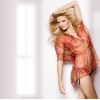|
 Tunic today
is the most popular and comfortable wear for summer time. This is too light and
sexual to attract attention to women and this is one of reasons why it is so
highly demanded for many seasons. A tunic is perfect clothing for the heat and
on the top of it, it is the best wear to visually correct the shapes if not
ideal. Presently we face with various styles and fabric for tunics and to some
particular extent they are all drawn towards the roots – the ancient civilizations
where they originated from. Tunic today
is the most popular and comfortable wear for summer time. This is too light and
sexual to attract attention to women and this is one of reasons why it is so
highly demanded for many seasons. A tunic is perfect clothing for the heat and
on the top of it, it is the best wear to visually correct the shapes if not
ideal. Presently we face with various styles and fabric for tunics and to some
particular extent they are all drawn towards the roots – the ancient civilizations
where they originated from.
A tunic is the
garment the present clothing originated from borrowing the base style. A tunic is known for the quite trivial structure
where two patches of fabric are fastened in between on shoulders, the waistline
and in the armpits. Women used to wear the tunic to conceal the shapes while
men used it a little bit of longer length, about half the knee.
A tunic was
typical clothing to wear in Ancient Rome and Greece used by ordinary people and
people from high society. It appeared differently, though. People from lower
layers of the society used to wear a plain tunic of simple tailoring. The
ensembles of the elite, senators and their wives looked quite different. The
nobles of the society in Ancient Rome and Greece used to wear tunics made
from streaming fabric, belting with thin or broad waistbands for more comfort
to have the particular status meaning.
The
clothing of the Romans differed from that of the Geek’s. The Roman men wore the
toga from above, a cape to cover the body, while women used to wear palla, the
peculiar rug to cover the shapes.
The Ancient
Greek were known to appreciate the beauty of the body and thus, the toga was
neglected for that purpose. The streaming clothes for women with open hands fastened
at shoulders and trapped under the bosom were the prototype of dresses that came
in favor later a-la Greek style.
The Arab invasions
into the territory of the Byzantine Empire till
the VIII century brought to quite obvious transformation in clothing.
The wardrobe acquired the oriental bloom so calledthe ethnic nature of
the costume.
The tunics then were decorated
with the luxury of eastern traditions. That was one of reasons among
others why
they became the favorite clothing for the high society members who liked
to
boast with wealth.
The tunic found
its dead season in Europe and during Middle Ages, though it was still fashionable
in the East and Africa adding peculiar
esthetics in every single country. And the Europeans and Americans used the
charm of ethnicity some time later.
The tunic
returned to civilization in the 60s of the XX century when the hippies tried to
create their own fashion of subculture. A tunic from India delivered by the travellers
was liked by celebrities who adopted the garment with an ease. Yves
Saint-Laurent perceived the trend and soon he launched the collection of tunics
in ethnic style. since that time the tunic is found in the wardrobe of
celebrities and ordinary people, luxury puffy women and slim girls. Fashion
Houses still launch spring and summer collections with this comfortable
garment.
As a
specially tailored garment, a tunic is extremely popular today. It is amazing
but tunic is found in autumn and winter collections by reputed brands. Lately a
tunic was presented as light garment from chiffon without buttons equally
suitable as the urban and beach wear. And today a tunic comes as jersey
clothing with falling down sleeves resembling sleeveless cardigan. Luxury silk of juicy color was used for tunics
in summer 2010 to make it resembling the cocktail dress of longer silhouette.
If and when
a fashionmonger today is willing to look like an ancient Roman or Greek woman,
she only has to opt for the stylized tunics which resemble the plain but luxury
tunics of ancient time in style and coloring.
In 2010 single-colored
tunics of rich shade are trendy resembling the Ancient Greek clothing in the
thin belt and V-shaped cut. The folk theme does not yield its positions with
oriental ornaments or Slavic patterns as prints and embroidery. The length of
tunics varies from the standard to below the waistline to the length of dresses
so much adopted as beach wear. Cotton, silk and chiffon appears as the most
suitable fabric for tunics.
The modern tunics
are launched by most famous brands, from democratic to elite. The cruise
collections offer tunics in huge versions. Laced models were demonstrated by Douglas
Hannant, while Helmut Lang presented the minimalist asymmetry in models from
delicate jersey. Chanel offers the light tunic similar to classic blouse, while
Jenni Kayne seemed to be innovative launching the tunic as the sailor's striped
vest.
|